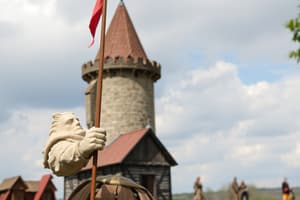Podcast
Questions and Answers
Which system exchanged land for military service during the Middle Ages?
Which system exchanged land for military service during the Middle Ages?
- Mercantilism
- Feudalism (correct)
- Manorialism
- Socialism
The Roman Catholic Church had no influence on scientific developments during the Middle Ages.
The Roman Catholic Church had no influence on scientific developments during the Middle Ages.
False (B)
What is the three-field system?
What is the three-field system?
A system of crop rotation where two fields are planted with crops while the third is left fallow.
The heavy plow was used to improve agricultural productivity in ______ Europe.
The heavy plow was used to improve agricultural productivity in ______ Europe.
Match the following medieval innovations with their descriptions:
Match the following medieval innovations with their descriptions:
Which of the following periods is considered part of the Middle Ages?
Which of the following periods is considered part of the Middle Ages?
Feudalism only influenced military strategies and had no impact on agriculture.
Feudalism only influenced military strategies and had no impact on agriculture.
What was the primary role of the Church during the Middle Ages?
What was the primary role of the Church during the Middle Ages?
Flashcards are hidden until you start studying
Study Notes
The Middle Ages
- The Middle Ages, or Medieval Period, spanned from the 5th to the 15th century in Europe.
- It followed the fall of the Western Roman Empire and preceded the Renaissance and Age of Discovery.
- The period is often divided into three sub-periods: Early, High, and Late Middle Ages.
Key Characteristics of the Middle Ages
- Feudalism: A social, political, and economic system where land was exchanged for military service.
- Lords provided protection, and vassals provided labor or military service.
- Manorialism: The economic structure where peasants worked on large estates (manors) owned by lords.
- Peasants produced food and goods in exchange for protection.
- Role of the Church: The Roman Catholic Church wielded immense power and influence.
- It influenced education, politics, and science during the Middle Ages.
The Importance of the Middle Ages
- This era laid the foundation for the future development of Western civilization.
- It was a time of significant social, technological, and intellectual transformations.
Medieval Agricultural Innovations
- Heavy Plow: An iron plow designed for deeper tillage in heavy soils of northern Europe.
- This increased agricultural productivity, especially in areas with historically low yields.
- Three-Field System: Rotated crops where two fields were planted, while the third was left fallow.
- This increased soil fertility and allowed for more land to be cultivated.
Studying That Suits You
Use AI to generate personalized quizzes and flashcards to suit your learning preferences.




